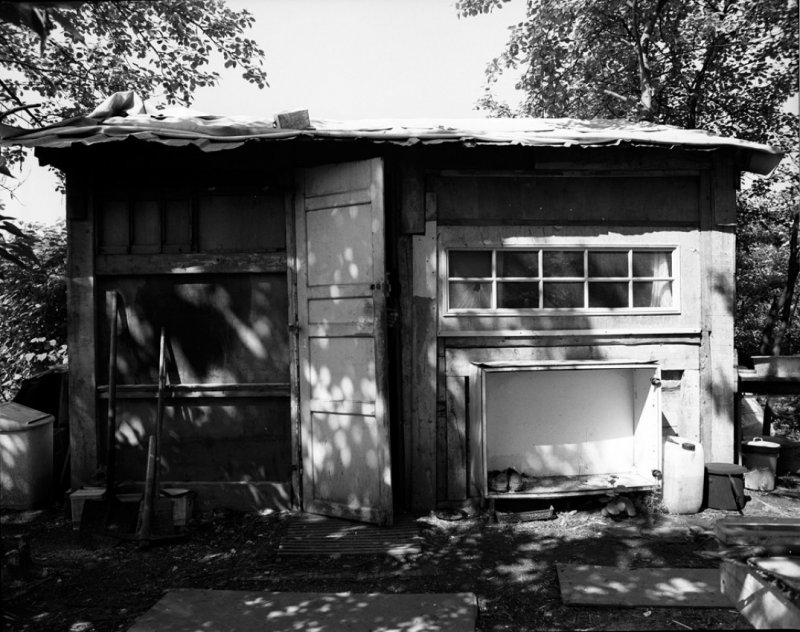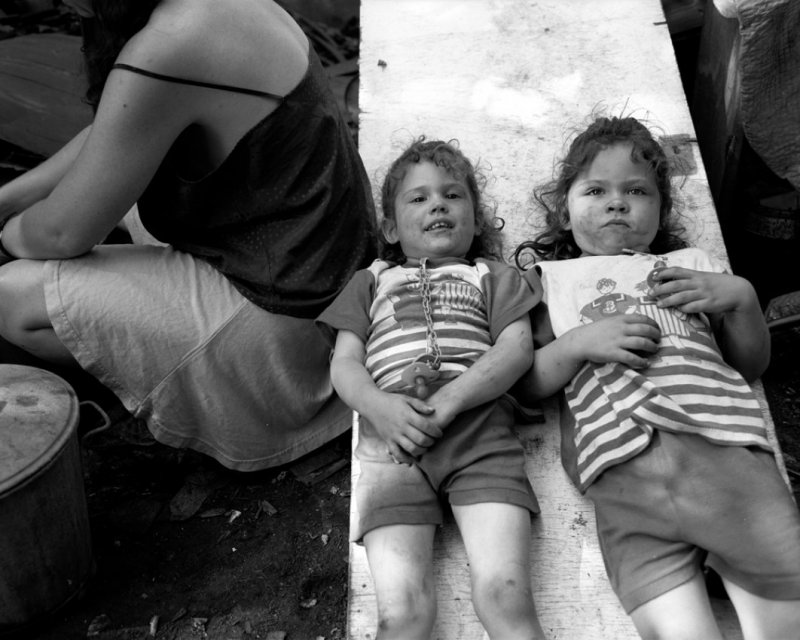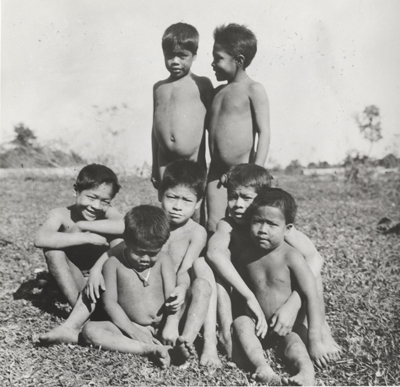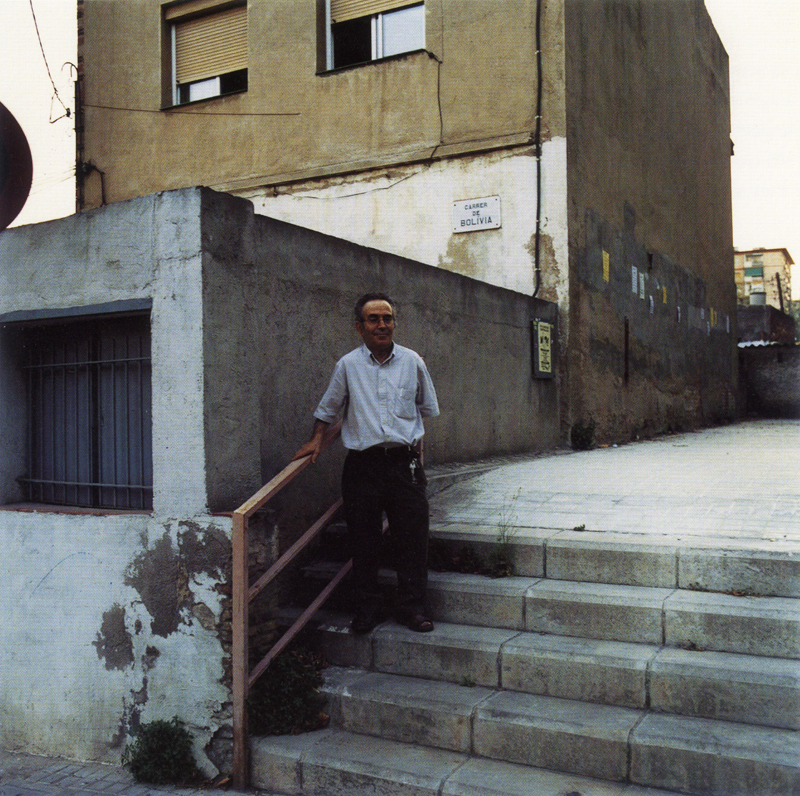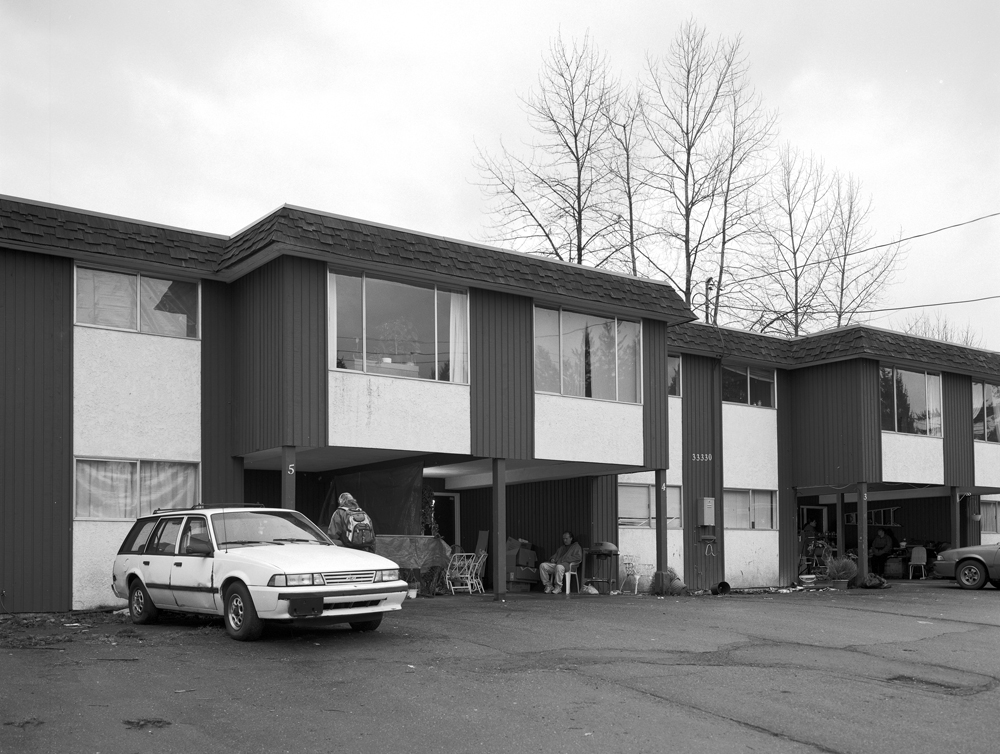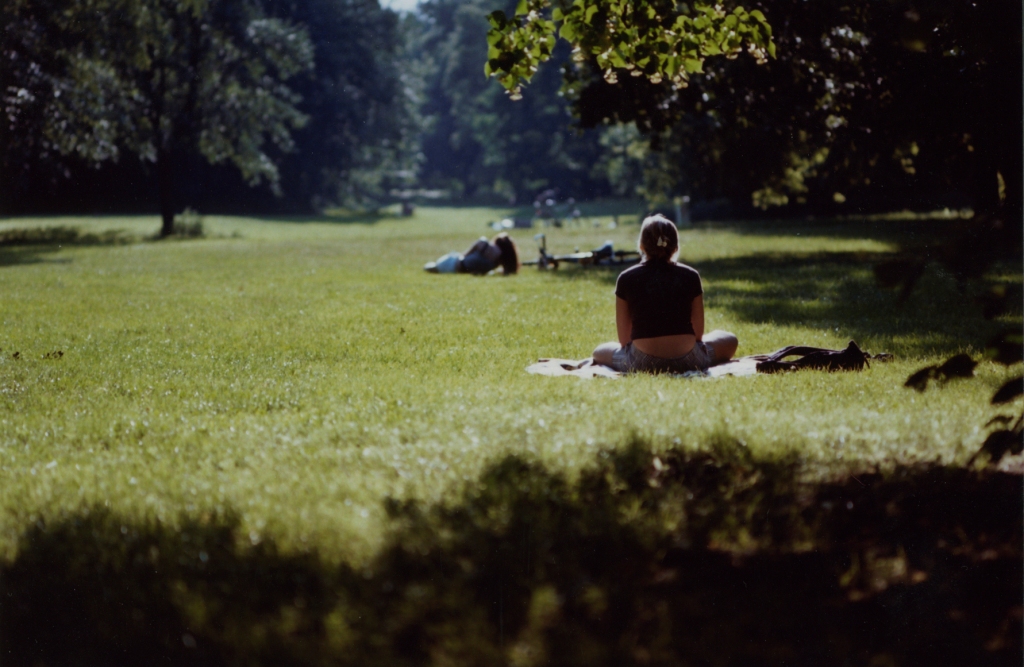—
Around the work of Ahlam Shibli
I have given the title “Intimité territoriale et espace public” to the argument that I am going to try to develop here, at Jeu de Paume. There will be three sessions between now and spring 2014: this lecture, then a second in the course of a study day with other contributors on 7 December, and, finally, a talk next spring, during the Robert Adams exhibition. You have probably noted the statement of intent. I am aware that I have given myself a rather broad programme. The notion of the territory does effectively call for a trans-disciplinary approach, and that is how I addressed it in the seminar titled, precisely, “Des territoires”, which I took for a long period at the École des Beaux-arts, and which gave rise to an exhibition on Quai Malaquais in late 2001. I continued this reflection in one of the essays in the book Des territoires, published in 2011 by Éditions L’Arachnéen. This book also comprises an essay on a series by Ahlam Shibli, Trackers, an excerpt from which is now being presented at Jeu de Paume.
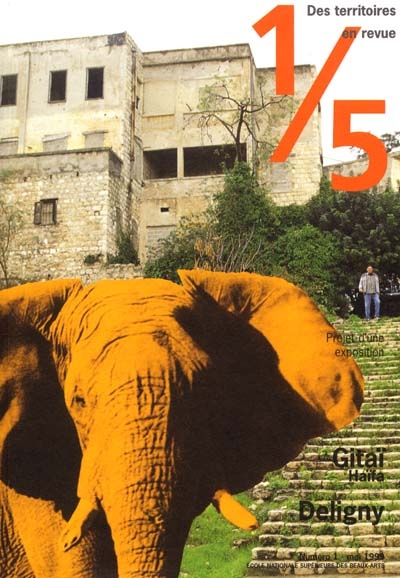

Covers of two issues of Des territoires en revue: No.1, May 1999 and No. 5, October 2001.
Like territory, intimacy (or privacy: intimité) and public space are polyvalent words whose meaning varies considerably with use. I do not intend to go too far into philological details, but we do need, as we say, to be clear about the words we are using, though without claiming to preclude all misunderstanding, since misunderstanding is part and parcel of communication. In this case, however, this understanding over words is necessary and it must be good enough, as Winnicott said, because the point is to understand how an experience, which I call “territorial intimacy,” and the images corresponding to it, whether photographic or otherwise, can contribute to the vitality of public space. I use this last term in the sense of the “public sphere,” that is to say, as the domain of exchange of opinions and deliberation, which is constitutive of democracy. In this sense, “public space” does not designate a material, physical reality but a dimension, an idea of social, cultural and political life. At the same time, of course, no exchange of opinions or deliberation is possible without a concrete space where individuals can meet.
In both cases, whether referring to the physical reality or to an ideological condition of social life, “public” is distinguished from “private.” This distinction is decisive for the definition and experience of privacy. In liberal democracies which, unlike totalitarian regimes, recognise both respect for the individual person and the right to property, the private/public distinction is foundational. It conditions the “production of space” (Henri Lefebvre). The fields of private and public are clearly delimited and protected from each other. In the city, public space is the sanctioned and more or less developed space which, unlike the private sphere, is accessible without exclusion (or without arbitrary restriction).
One of the commonplaces of documentary photography, when it aspires to social critique, is to denounce the privatisation of public space. This phenomenon is often confused with the various forms of security-based segregation generated by the proximity of rich and poor in the city. The rich protect themselves and voluntarily exclude themselves from the common space, having first tried to exclude the poor. It is both banal and right to say that this phenomenon has grown with the neo-liberal turn taken by the world economy since the 1980s. Well before that, however, Hannah Arendt denounced the “privative” definition of privacy advanced by the privileged beneficiaries of modern progress. “Privative” is a negative term which indicates a lack: privative privacy is a lack of relations, a negation of the outside, a form of seclusion. According to the Larousse dictionary, in French “seclusion” refers to a “physiological adaptation whereby an animal or plant isolates itself from its milieu, passively preventing unfavourable actions from impacting on it.” It’s a nice definition, which refers to the ethological conception of the territory. But of course, this kind of functioning in the plant and animal world becomes more complicated when transposed to human societies. Privative privacy is the consecration or the symptom of a social incompatibility.
By isolating themselves, the rich deprive themselves of common space: they break the exchange and the dialectic between the private and the public. The poor also experience this privation but they do not impose it on themselves, it is inflicted on them. The homeless person is deprived of the private space that would allow her to use public space as public: by unduly appropriating a portion of public space she limits its common use. What appears in developed countries as an abnormal alteration of public space is the ordinary regime of the so-called “wild” habitat in many other countries. The sociologist Jean Remy has coined the term “weak legitimacy spaces” for the emplacements of makeshift, precarious housing appropriated by individuals or groups.
As far as I know, the architect Yona Friedman was the first person to have identified the distinctive character of these precarious dwelling spaces in the socio-juridical imaginary. In Architecture de survie (1978) he points out that “bidonvillage” (literally, shantytownship), that is, a shanty town on a village scale, transforms the notions of “public” and “private.” He then observes that, “As regards property, the dominant practice in the bidonvillage is similar to that of most tribal societies: it consists in considering that a thing belongs to the person who holds it, or knows how to use it. A piece of land, for example, belongs to the person who has managed to build a fence around it, or a roof to cover it. 1
This observation fits the images that, some time ago now, gave me the idea of territorial intimacy. These were photographs taken by Marc Pataut in 1994–95 of the inhabitants of Le Cornillon, a brown-field site in the Plaine Saint-Denis, where construction of the Grand Stade de France (football and athletics stadium) began in 1995. 2
« Ceux du terrain, Grand Stade, Cornillon nord — La plaine Saint-Denis, 1993/1994 ». Black and white silver prints, 9 x 15 cm. Lundi 31 janvier 1994, Noel devant sa tente. © Marc Pataut
Le Cornillon was an abandoned industrial site, an urban wasteland where the public authorities decided to build the Grand Stade. Pending the beginning of work, the land was occupied by a small group of homeless people, single individuals and one or two families with children. Pataut’s images describe a makeshift, improvised community. As a visitor, the photographer got to know the inhabitants: he entered their private worlds, you might say. There was a close relation between the intimacy of the reportage and the appropriation of the territory. This relation is confirmed in the work of Ahlam Shibli.
Intimacy is generally associated with a private, or even private experience of closeness to oneself and to other persons, who indeed are called “close,” in a space that is to some extent protected. This definition implies a separation of the private and the public that must be respected by both institutions and the social actors themselves. But Pataut’s reportage reveals a dimension of intimacy that tends to do away with this distinction. Here, intimacy designates the appropriation as a living space of a territory not assigned to that use. Appropriation is not ownership.
The intimacy defined by a feeling of closeness to ourselves and to others can take on a variety of emotional tones, from euphoria to fatigue. The feeling of closeness is inclusive, but it extends, as we say, gradually – from “close (person) to close (person)” as the French expression de proche en proche has it. The area for experiencing it is generally, and aptly, limited to the space around the individual’s body (the body in the first person) and to domestic or communal space. Territorial intimacy thus comprises this dimension of experience de proche en proche but it is not the intimacy of the private, domestic sphere. It is constituted on the frontiers of public space, in the grey or forsaken zones of the sanctioned territory. This dimension appears to be linked to situations of marginality or exclusion. It characterises an environment that is other and diverse, and that may be both a reservoir of the picturesque and exotic, and an occasion for social and political experiment.
When I first saw Pataut’s images, they brought to mind a contemporary tableau by Jeff Wall, The Storyteller (1986). The place represented in this tableau is a residual space under an urban motorway: a sloping triangle covered with scrawny wild grass where a number of figures sit, including, on the left, the group that gives the composition its title: a storyteller, male or female, and two listeners. Here, territorial intimacy is produced in a demonstrative, theatrical way: it results from a narrative performance taking over a refuge-like space. The situation of social relegation is summed up in the solitary figure sitting under the bridge on the right. The circle with the storyteller balances this solitary figure. Unlike the squatters at Le Cornillon, the figures in this photographic tableau do not live in this neglected urban space but are occupying it provisionally, transforming it by speech into a marginal, impromptu public space. In the image, the story is inaudible. But it is constitutive of the visual fable.
I recently compared the images of Le Cornillon to the ones published by Pierre Clastres in Chronique des Indiens Guayaki (Plon, “Terre humaine,” 1972). These images constitute a magnificent sequence of ethnopoetic documents. Here light, the vector of photographic recording, is above all the ambient element in which the bodies are steeped. The territory is represented through multiple indications forming a diversified landscape as complex as body language. Postures, actions and attitudes define the situations witnessed by the outsider-visitor. Quite clearly, territorial intimacy here has to do with a reciprocal inclusion of the body and the environment. It is innocent of the institutional private/public division which governs modern administrative societies, for the good and simple reason that the Guayaki have no notion of this division.
Appropriation is not ownership. This distinction corresponds to an anthropological reality. It is also based on an imaginary, or even a utopia of the organic, solidarity-based community. That it why, in his remarks on bidonvillage, Yona Friedman evokes “tribal societies.” The analogy is contestable. It mixes up a cultural elsewhere, which has no notion of urban segregation, and an alternative cobbled together within an administered urban culture (founded on the juridical distinction between private and public). The analogy between bidonvillage and “tribal” space results from a nostalgia which confounds the creativity of marginals and “primitive” archaism. But the fact remains that a survival economy set up to palliate the effects of an inegalitarian economy can flow into the logic of a solidarity-based economy founded on the sharing of limited resources.
Intuitively, “territorial intimacy” sounds to us like an oxymoron, the coupling of a mutually contradictory noun and adjective. This contradiction is interesting in itself. The connotations or associations of ideas linked to the two words pull in opposite directions. As I have already said, intimacy is generally associated with a private, or even privative experience of proximity to the self and to others, in a delimited, more or less protected place. In its first, geographical sense, a territory is an expanse occupied by a human group. A territory can be constricted, but generally the word suggests an expansive movement. We speak frequently of “territories of intimacy,” but this is a metaphorical expression which obliterates geography. We no longer hear the oxymoron.
In societies governed by a recognised, instituted private/public relation, domestic space is the privileged domain of intimacy, which itself is considered to be the kernel of biographical identity. This preference has become more pronounced in a media-driven culture which partakes in and is constitutive of mass individualism. The phenomenon stems from a historical tradition. The visual arts, and what is known in English as the pictorial tradition have, since the spread of the genre portrait in the seventeenth century, provided inexhaustible models for an immemorial set of images.
Photos : Patrick Faigenbaum
In France, Patrick Faigenbaum is no doubt the artist who has worked in this tradition with the greatest persistence and success – and here I am talking about the quality of the images. His great obsession is composition, that which traditionally enables the combination of figures and places, but also of interior and exterior. The family constitutes itself as a picture in a setting which itself includes tableaux. The portrait of the Del Drago family (Rome, 1987) shows, among many other things, that composition is based on a principle of redundancy, which in this instance produces an involuntary comic touch. The figures acquire a public dimension through representation, which is addressed to the art-going public. But a segment of city can constitute another setting, a setting that is other, for a figure who has constituted himself as an actor in the public sphere: Senor Gil, headmaster of a school in the Besòs quarter of Barcelona, is at home in the street. He holds the keys to the neighbourhood, if not the city. Free of systematic aims, Faigenbaum’s portraits have come to constitute an inventory of the private-public relation interpreted by composition, based on a pictorial tradition of the space of domestic intimacy. At the same time, his first image, or at least the one that for many years, until a very recent date, he presented as such, is not a domestic view. Far from it. It was taken in the street in Boston in July 1974. For a body of work in which the place of the portrait is preponderant, it constitutes a rather paradoxical introduction, a strange threshold. Faigenbaum has inscribed his own artistic biography under the sign of an image that contradicts the domestic definition of intimacy.
Intimacy is considered an essential, secret and even occult quality of private space. In the absence of a space of one’s own – I am thinking here of Virginia Woolf’s “room of one’s own” — the dimension of the secret and the hidden is reduced to the body. Such is the homeless person’s experience. A homeless person is someone who cannot lay claim to a private space in order to affirm her identity and her right to public space. She is deprived of the support that is private space. She is therefore exposed, literally, and without protection, to the gaze of others, just as she is to the dangers of the public thoroughfare. Her intimacy is reduced to the minimum of her own body. But there is also the legend of the philosopher-tramp which goes back to the figure of Diogenes. The philosopher-tramp is a militant of public space. Ideally, he is deprived of nothing because he has nothing. He is emancipated from privative norms. Obviously, this ideal is contradicted by the reality of everyday precariousness and suffering. However, the figure of Diogenes shows how the minimal definition of the intimate connects with the ideal of public space.
The minimal definition of intimacy corresponds to the body, but also to the ideal of an imprescriptible identity of the person, condensed in the inner self, that is to say, the tribunal of conscience. The intimate distinguishes private space from public space. Nevertheless, it is remarkable that in the French term for inner self or heart of hearts, le for intérieur, the word for points us to the Latin forum, which is the archetypal space of deliberation, that is to say, public space par excellence. That is why we can say that the philosopher-tramp is a militant of public space.
Furthermore, and without invoking the example of Diogenes, intimacy, as a proximity to the self, cannot be reduced to a spatial distribution, nor to a domestic typology; it belongs to a psychological or psychosocial register, and it induces a “body-image,” in the sense understood since the work of the psychoanalyst Paul Schilder. In his seminal book, published in English in 1935, Schilder wrote:
“We expand and contract the postural model of the body; we take parts away and we add parts; we rebuild it; we melt the details in; we create new details; we do this with our body and with the expression of the body itself. We are continually experimenting on the body-image. […] One should not speak so much about growth and evolution, when one means by it something passive and automatic. One should emphasize the continual activity, the trying out. One may speak of growth and passing of shapes, ‘gestalten’. But here again one should be aware that one is not dealing with automatic development but with a tendency of the constructive life energy. […] In the phases of construction and destruction, two principal human tendencies come out. One is the tendency to crystallize units, to secure points of rest, definiteness, and absence of change. The other is the tendency to obtain a continual flow, a continuous change.” 3
The body-image, therefore, is never frozen, never fixed: it is constantly being unmade and remade. Schilder speaks of destruction and reconstruction. The body-image derives from the experimental alternation of these two tendencies. Another psychoanalyst, Didier Anzieu (Le Moi-peau, 1995), has shown how the body is an envelope that brings into play the interior/exterior relation, based on the contact zone that is the skin. In an article published in 1974 Anzieu identified the functions of this “skin-ego”: to envelop, protect, and filter, for which there are three corresponding images: the bag, the screen and the sieve.
The image of the body as an envelope (with the complementary functions of protecting and filtering) may be a model for thinking about and envisioning both the environment of intimacy and the domestic interior as environment. Roberto Matta demonstrated this in a set of studies done in coloured pencil and collage (1936). One of them was reproduced in black and white in the journal Minotaure (no. 11, spring 1938), accompanied by a text titled “Mathématique sensible, architecture du temps” (Sensitive Mathematics, Architecture of Time). These images constitute an extraordinary speculation about the “interior” (the inside space of the dwelling) as an extension of the body, that is to say, about both the body inside the body-interior, that is to say, the body transformed into an interior. Matta exploits the porosity of the interior. Territorial intimacy, as I understand it here, presupposes this corporeal porosity, which tends to abolish the distinction between outside and inside.
As for the notion of territory, it is geographic. In this sense, it designates data that generally overflow the space of intimacy associated with private life. The word is also used in ethology. And, as I have pointed out in the text referred to at the beginning of this talk, it may be this ethological dimension which allows us to establish a strong imaginary relation between geography and body-image. The image of the spider’s web acts as a model here, one that is constantly rehearsed by writers and artists.
A fine example of intimacy open onto a territory is the Jeff Wall tableau A View from an Apartment (2004–5). The opening is effected by the “view.” The view (veduta) is a sub-genre of landscape, and also the typical image of a territory transformed into a landscape, in keeping with the primacy given to visual perception in the descriptive or documentary approach to the environment. In the picture by Jeff Wall, the territory (Vancouver harbour) penetrates domestic space. The uniform light level of interior and exterior disrupts photographic habits. Domestic space has lost its intimacy to the advantage of the view. However, domestic intimacy appears in another picture by Wall, Tenants (2007), which is a view in black and white.
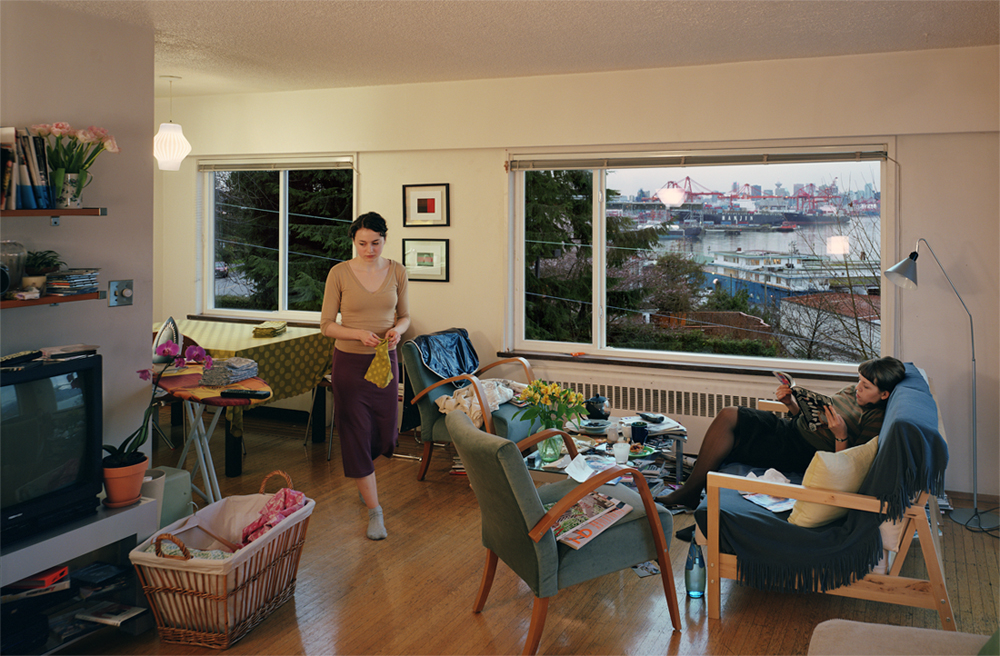
Jeff Wall, A view from an apartment, 2004-2005. Transparency in lightbox, 167.0 x 244.0 cm. Courtesy of the artist ©Jeff Wall
As it happens, Jeff Wall and I spoke at length about the picture, here in this room, during a conversation in December 2007. I had suggested that the details in this image could be compared to views of picturesque spots chosen in nineteenth-century photographs. When I asked Wall what there was behind the houses and what the space was on the ground floor – the fronts of the houses or the garages behind –, he said he would rather not answer. He didn’t want to give any precise information. He found the ambiguity interesting, he didn’t want to clear it up. He did, say, however, that it was perhaps typical of this kind of housing. He pointed out that this space, located to the front or the back of the house, is characteristic of a kind of housing that is very common in North America, but that doesn’t have a name. I quote: “The house is raised up on posts and this creates an underneath space. The underneath space isn’t defined; it has no real name. In fact in English, I don’t think there is a name for that space. Some people use it to put their cars in, some don’t. As you can see, these people tend to use it for other things. The two ladies talking at the far end use it for another outdoor room, like a patio. The third person closer to us uses it as a kind of storage. But those facts are absorbed into the picture, that’s my point. The space has no name.”
To sum up, there is in the architecture of these houses an indeterminacy which gives the inhabitants a certain freedom of use. I find it very interesting that this open space on the ground floor, which can be used in different ways, should have no name. Indeterminacy and functional flexibility are no doubt the conditions for an invention of intimacy which corresponds to experimentation with the body-image.
Onto this first set of remarks I would now like to graft a few observations that I made when I saw the exhibition by Ahlam Shibli. In that part of the world long known as Palestine, the word “territories” has taken on a particular meaning: it designates an occupied country, expropriated lands, colonisation and desperate acts of resistance. Here, as elsewhere, territorial intimacy can be a subjective experience, but it is also, and primarily, a right denied to a people. Shibli combines these two definitions.
I was enthusiastic about the exhibition. I have always admired Shibli’s work and I shall try to say why, but I must say that up to now I had always been a bit disappointed by the way she showed her images. She didn’t quite manage to find an equivalent in the exhibition space to the sequential montage of images in the book. I was particularly disappointed by her contribution to Les Inquiets, held at the Pompidou Centre in 2008. In contrast, I find the articulation of the current exhibition here at Jeu de Paume quite remarkable. The relative exiguousness of the exhibition rooms on the ground floor has worked to her advantage. The hanging is dense. It is simple, free of staging effects or useless installations. In the first two rooms one may get the impression of a simple deployment of the sequences constituted for the book. But the transposition is effective, strengthened by an overall effect of density. This effect is confirmed later on and culminates in the two rooms where the remarkable final ensemble is presented. It also constitutes the main content of the book published parallel to the exhibition. My only reservation concerns the alignment of small images from the Self-portrait on the entrance wall. I would maybe have liked to see more images from the Eastern LGBT series, which is indeed deserving of lengthy commentary. But these two little quibbles do not change the essential. The essential is that this is a necessary exhibition, extremely sound, of the kind one doesn’t often see.
The power of Ahlam Shibli’s images naturally has to do with the subject she addresses. The subject is the material and principle of photographic reportage, which is a speciality of visual information. Generally, the subjects of photojournalism are dictated by current events. Photojournalists work for media news, which is governed by production norms (because media news is a commercial service). Usually, then, reporters do what they are told to do: their margin for initiative is narrow. Sometimes, they invent their subject, but that is rare. I have spoken of “reportage for private use” to describe the way, parallel to his professional work, Robert Doisneau produced a body of documentary images that were not commissioned, or were self-commissioned. Shibli has sometimes responded to commissions (in Barcelona in 2007 and Tulle in 2008–9), but as a guest artist (or artist in residence). On each occasion she has defined her subject, taking the limits of a given urban territory as her only constraint. The sets of images corresponding to these two commissions consequently have the same quality as the reportage that she decided on alone, that she commissioned from herself.
Reportage defined itself as the media extension of a hybrid register of illustration that was constituted by mixing examples of “genre” (the genre portrait or scene) with history painting. Thanks to the support of illustration, the model of the literary chronicle was grafted onto the visual material of everyday life. Every kind of reportage does in effect imply a narrative, which involves a montage of images and texts. We speak sometimes of “auteur reportage”: the formula derives from the vocabulary of cinema and covers the same ambiguities. Standing apart from ordinary photojournalism, auteur reportage is constituted as small-scale, luxury production, close to “creative photography.” But it is hard to fit Shibli’s work into this framework. She is one of these people who does not like to fit in, or be fitted in! As her passport indicates, she has Israeli nationality, but she thinks of herself as a Palestinian. Her conception of reportage evinces the same will to independence and self-determination. She has recovered or reinvented the parameters of reportage for her own use.
The first parameter is duration: reportage implies an extended immersion in a specific social and historical situation. But duration is not a guarantee of pertinence. What is remarkable in Shibli’s images is the rightness of the photographic situation. Each photographic situation is constituted by an encounter which reinvigorates the social situation taken as the subject of the investigation. This was clearly visible in the images of Trauma. The social situation is reinitiated with each new encounter. A recurrent trope in Trauma is the action of a person showing Ahlam documents: photographs, maps, manuscripts. The meaning these elements hold for their owner varies, and they may be more or less decipherable in the images where they appear. This appearance produces a mise en abyme of the photographic images, especially when the document presented is a photograph. Abyme designates the depth from which the document emerges, in the presentness of the encounter.
Views of the exhibition “Ahlam Shibli. Phantom Home” at the Jeu de Paume. Ahlam Shibli, Series Trauma, chromogenic prints. Courtesy Ahlam Shibli. Photo Adrien Chevrot © Ahlam Shibli, Jeu de Paume 2013.

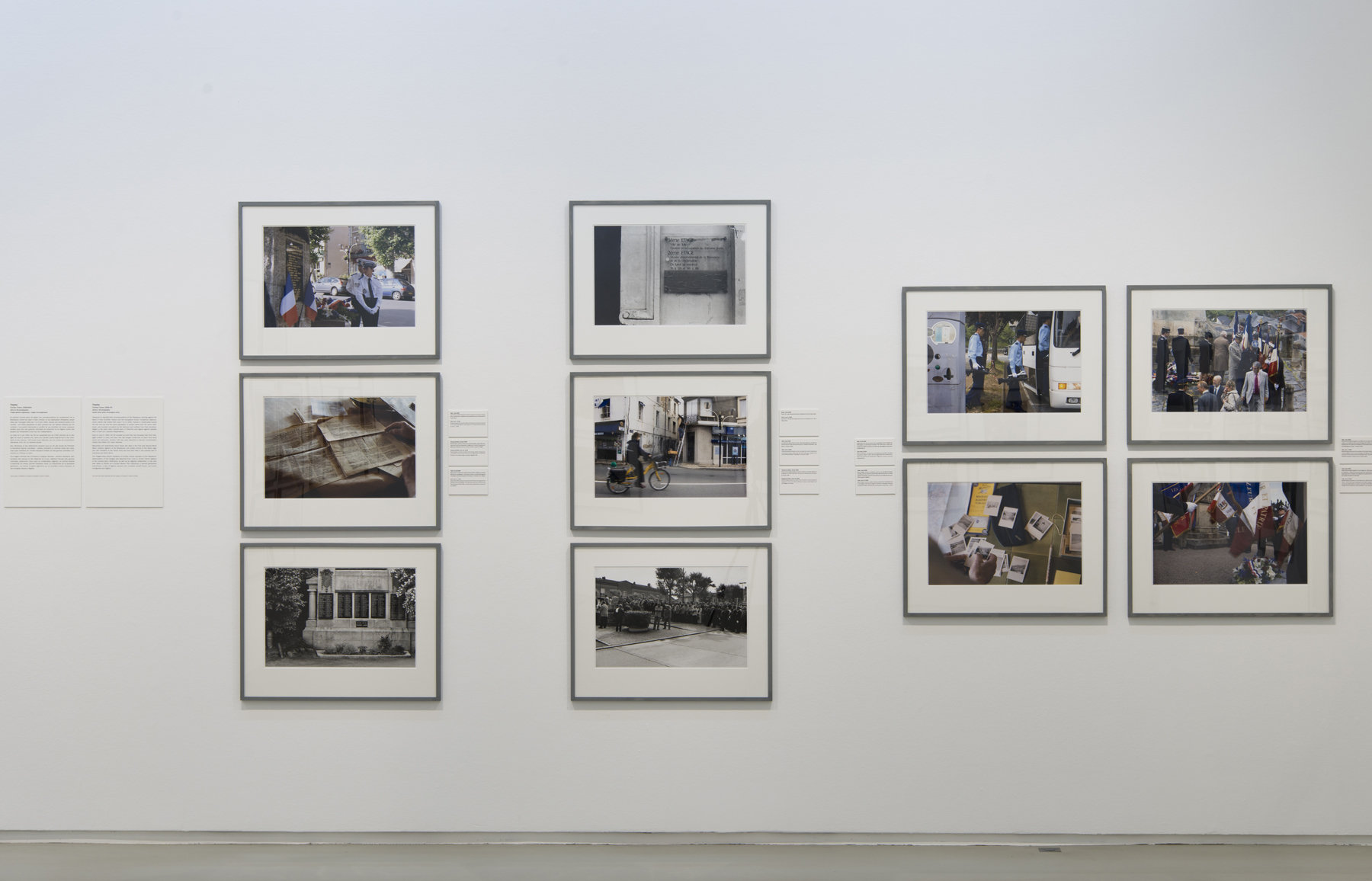

This schema of the photographic situation is also found in Death, but the mise en abyme is extended, in several ways. First of all, the images are often bigger, as are the images in the image. They are often the size of a poster in the street, for domestic space is penetrated by public space. Later, the absent people figured “as martyrs” are close (they died recently), they are closer than the historical figures in Trauma. At the same time, they are more distant, because they have an aura of legend. The space of domestic intimacy is dramatised, and Shibli takes the drama out of it. For me, this tension is constitutive of the power of images. Indeed, there is, in the ensemble simply titled Death, a response to the mystifications of history, whether related by the winners or by the losers. It is no longer a matter of revealing a double historical content, as in Trauma, where the history of the heroes and martyrs of the Resistance allows another history to appear: that of colonial oppression. The incisive monosyllabic title, Death, convokes its contrary, Life. Territorial intimacy here is the lyrical narrative, in images, of a combat with death, that is to say, also, the presence-absence of the dead. It is set in a territory where the private-public division is constantly blurred. Shibli describes this blurring, but with a rightness and a clarity that make it possible to overcome the fascination of catastrophe.
Jean-François Chevrier, 2013
Translated from French by Charles Penwarden
Views of the exhibition “Ahlam Shibli. Phantom Home” at the Jeu de Paume. Ahlam Shibli, Series Death, chromogenic prints. Courtesy Ahlam Shibli. Photo Adrien Chevrot © Ahlam Shibli, Jeu de Paume 2013.


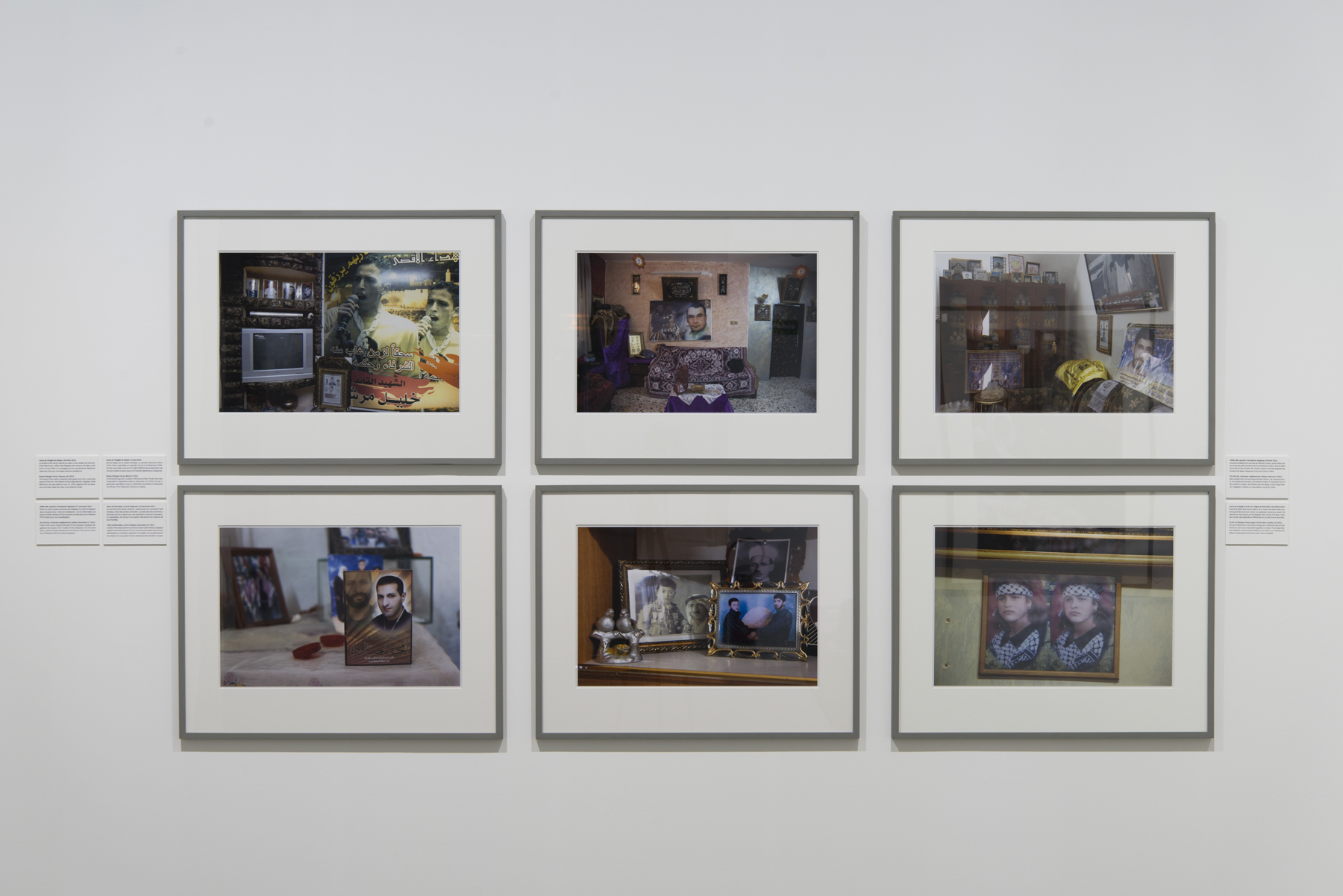
Intimité territoriale et espace public, led by Jean-François Chevrier, which will unfold in three parts up to spring 2014.
________________________________________
Notes
References

